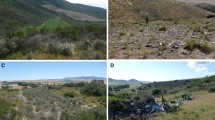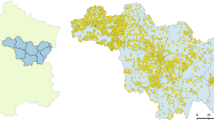Abstract
The fragmented landscape of the Midwest USA includes prairie remnants embedded in an agricultural matrix, potentially impermeable to dispersing individuals. We examined butterfly responses to local (environmental variables measured within the prairie fragment itself such as vegetative characteristics) and landscape (environmental variables measured up to 2 km surrounding the fragment, but not the fragment itself) factors at 20 prairie remnants in Iowa. Our objectives were to: 1) document how the composition and configuration of the landscape affects butterfly community within the fragment, 2) determine whether explanatory power is gained by including both landscape and local variables rather than only local variables, and 3) analyze differences in butterfly community composition between linear and block shaped fragments. Results from partial least squares regression suggest there are significant effects of the landscape on butterfly community composition at all spatial extents investigated. The local variable that was most highly correlated with butterfly community response was percentage litter, while percentage of roads was the most important variable at all landscape spatial extents. Ordination diagrams clearly separate linear from block sites based on butterfly community composition. Variance partitioning using partial canonical correspondence analysis indicated that landscape variables at all spatial extents add additional explanatory power beyond local variables with little overlap in percentage of variation explained. Our results suggest that butterflies are making decisions based both on the local and landscape environmental factors, thus land surrounding prairie remnants should be included in management decisions.





Similar content being viewed by others
References
Auckland JN, Debinski DM, Clark WR (2004) Survival, movement, and resource use of the butterfly Parnassius clodius. Ecol Entomol 29:139–149
Baguette M, Mennechez G, Petit S, Schtickzelle N (2003) Effect of habitat fragmentation on dispersal of the butterfly Proclossiana eunomia. Comptes Rendus Biologies 326:S200–S209
Bergin TM, Best LB, Freemark KE, Koehler KJ (2000) Effects of landscape structure on nest predation in roadsides of a midwestern agroecosystem: a multiscale analysis. Landscape Ecol 15:131–143
Bergman KO, Askling J, Ekberg O, Ignell H, Wahlman H, Milberg P (2004) Landscape effects on butterfly assemblages in an agricultural region. Ecography 27:619–628
Borcard D, Legendre P, Drapeau P (1992) Partialling out the spatial component of ecological variation. Ecology 73:1045–1055
Cant ET, Smith AD, Reynolds DR, Osborne JL (2005) Tracking butterfly flight paths across the landscape with harmonic radar. Proc Roy Soc London: Ser B 272:785–790
Chust G, Pretus JL, Ducrot D, Bedòs A, Deharveng L (2003) Response of soil fauna to landscape heterogeneity: determining optimal scales for biodiversity modeling. Conserv Biol 17:1721–1723
Clausen HD, Holbeck HB, Reddersen J (2001) Factors influencing abundance of butterflies and burnet moths in the uncultivated habitats of an organic farm in Denmark. Biol Conserv 98:167–178
Collinge SK, Prudic KL, Oliver JC (2003) Effects of local habitat characteristics and landscape context on grassland butterfly diversity. Conserv Biol 17:178–187
Conradt L, Bodsworth EJ, Roper TJ, Thomas CD (2000) Non-random dispersal in the butterfly Maniola jurtina: implications for metapopulation models. Proc Roy Soc London: Ser B 267:1505–1510
de Jong S (1993) SIMPLS: an alternative approach to partial least squares regression. Chemometr Intell Lab Syst 18:251–263
Debinski DM (2006) Forest fragmentation and matrix effects: the matrix does matter. J Biogeo 33:1791–1792
Debinski DM, Ray C, Saveraid EH (2001) Species diversity and the scale of the landscape mosaic: do scales of movement and patch size affect diversity? Biol Conserv 98:179–190
Dennis RLH, Shreeve TG (1997) Diversity of butterflies on British islands: ecological influences underlying the roles of area, isolation, and the size of the faunal source. Biol J Linn Soc 60:257–275
Dennis RLH, Shreeve TG, Van Dyck H (2003) Towards a functional resource-based concept for habitat: a butterfly biology viewpoint. Oikos 102:417–426
Dover JW (1996) Factors affecting the distribution of satyrid butterflies on arable farmland. J Appl Ecol 66:723–734
Dover JW, Fry GLA (2001) Experimental simulation of some visual and physical components of a hedge and the effects of butterfly behaviour in an agricultural landscape. Entomol Experiment Appl 100:221–233
Dover JW, Sparks TH, Greatorex-Davies JN (1997) The importance of shelter for butterflies in open landscapes. J Insect Conserv 1:89–97
Environmental Systems Research Institute (2004) ArcGIS: release 8.3. Redlands, California
Fahrig L, Merriam G (1994) Conservation of fragmented populations. Conserv Biol 8:50–59
Graham CH, Blake JG (2001) Influence of patch- and landscape-level factors on bird assemblages in a fragmented tropical landscape. Ecol Appl 11:1709–1721
Haddad NM (1999a) Corridor and distance effects on interpatch movements: a landscape experiment with butterflies. Ecol Appl 9:612–622
Haddad NM (1999b) Corridor use predicted from behaviors at habitat boundaries. Am Nat 153:215–227
Haddad NM, Baum KA (1999) An experimental test of corridor effects on butterfly densities. Ecol Appl 9:623–633
Harrison S (1989) Long-distance dispersal and colonization in the bay checkerspot butterfly Euphydryas editha bayensis. Ecology 70:1236–1243
Hendrix SD, Kyhl JF (2000) Populations size and reproduction in Phlox pilosa. Conserv Biol 14:304–313
Hines HM, Hendrix SD (2005) Bumble bee (Hymenoptera: Apidae) diversity and abundance in tallgrass prairie patches: effects of local and landscape floral resources. Environ Entomol 34:1477–1484
Jeanneret Ph, Schüpbach B, Pfiffner L, Walter T (2003) Arthropod reaction to landscape and habitat features in agricultural landscapes. Landscape Ecol 18:253–263
Johansson ME, Nilsson C (2002) Responses of riparian plants to flooding in free-flowing and regulated boreal rivers: an experimental study. J Appl Ecol 39:971–986
Jones RE, Gilbert N, Guppy M, Nealis V (1980) Long-distance movement of Pieris rapae. J Animal Ecol 49:629–642
Kindlmann P, Aviron S, Burel F, Ouin A (2004) Can the assumption of a non-random search improve our prediction of butterfly fluxes between resource patches? Ecol Entomol 29:447–456
Kopper B, Charlton R, Margolies D (2000) Oviposition site selection by the regal fritillary, Speyeria idalia, as affected by proximity of violet host plants. J Insect Behavior 13:561–565
Krauss J, Steffan-Dewenter I, Tscharntke T (2003) How does landscape context contribute to effects of habitat fragmentation on diversity and population density of butterflies? J Biogeo 30:889–900
Kuussaari M, Nieminen M, Hanski I (1996) An experimental study of migration in the Glanville fritillary butterfly Melitaea cinxia. J Animal Ecol 65:791–801
Lima SL, Zoller PA (1996) Towards a behavioral ecology of ecological landscapes. Trends Ecol Evol 11:131–135
Lord JM, Norton DA (1990) Scale and the spatial concept of fragmentation. Conserv Biol 4:197–202
Luoto M, Kuussaari M, Rita H, Salminen J, von Bonsdorff T (2001) Determinants of distribution and abundance in the clouded apollo butterfly: a landscape ecological approach. Ecography 24:601–617
Matter SF, Roland J (2002) An experimental examination of the effects of habitat quality on the dispersal and local abundance of the butterfly Parnassius simintheus. Ecol Entomol 27:308–316
Mazerolle MJ, Villard M-A (1999) Patch characteristics and landscape context as predictors of species presence and abundance: a review. Ecoscience 6:117–124
Merckx T, Van Dyck H, Karlsson B, Leimar O (2003) The evolution of movements and behaviour at boundaries in different landscapes: a common arena experiment with butterflies. Proc Roy Soc London: Ser B 270:1815–1821
Mevik B-H (2006) The pls package. R News 6:12–17
Miller JR, Dixon MD, Turner MG (2004) Response of avian communities in large-river floodplains to environmental variation at multiple scales. Ecol Appl 14:1394–1410
Opler PA, Krizek GO (1984) Butterflies east of the great plains: an illustrated natural history. The John Hopkins University Press, Baltimore, Maryland, USA
Ouin A, Aviron S, Dover J, Burel F (2004) Complementation/supplementation of resources for butterflies in agricultural landscapes. Agric Ecosyst Environ 103:473–479
Pearson SM (1993) The spatial extent and relative influence of landscape-level factors on wintering bird populations. Landscape Ecol 8:3–18
Pywell RF, Warman EA, Sparks TH, Greatorex-Davies JN, Walker KJ, Meek WR, Carvell C, Petit S, Fairbank LG (2004) Assessing habitat quality for butterflies on intensively managed arable farmland. Biol Conserv 118:313–325
R Development Core Team (2004) R: a language and environment for statistical computing. R Foundation for Statistical Computing, Vienna, Austria
Reeder KF, Debinski DM, Danielson BJ (2005) Factors affecting butterfly use of filter strips in Midwestern USA. Agric Ecosyst Environ 109:40–47
Ribic CA, Sample DW (2001) Associations of grassland birds with landscape factors in southern Wisconsin. Am Midland Nat 146:105–121
Ricketts TH (2001) The matrix matters: effective isolation in fragmented landscapes. Am Nat 158:87–99
Ries L, Debinski DM (2001) Butterfly responses to habitat edges in the highly fragmented prairies of Central Iowa. J Animal Ecol 70:840–852
Ries L, Debinski DM, Wieland ML (2001) Conservation value of roadside prairie restoration to butterfly communities. Conserv Biol 15:401–411
Samson F, Knopf F (1994) Prairie conservation in North America. BioScience 44:418–421
Saunders DA, Hobbs RJ, Margules CR (1991) Biological consequences of ecosystem fragmentation: a review. Conserv Biol 5:19–32
Sawchik J, Dufrene M, Lebrun P (2003) Estimation of habitat quality based on plant community, and effects of isolation in a network of butterfly habitat patches. Acta Oecologica 24:25–33
Schneider C (2003) The influence of spatial scale on quantifying insect dispersal: an analysis of butterfly data. Ecol Entomol 28:252–256
Schneider C, Fry GLA (2001) The influence of landscape grain size on butterfly diversity in grasslands. J Insect Conserv 5:163–171
Schultz CB, Crone EE (2001) Edge-mediated dispersal behavior in a prairie butterfly. Ecology 82:1879–1892
Shepherd S, Debinski DM (2005) Evaluation of isolated and integrated prairie reconstructions as habitat for prairie butterflies. Biol Conserv 126:51–61
Sparks TH, Parish T (1995) Factors affecting the abundance of butterflies in field boundaries in swavesey fens, Cambridgeshire, UK. Biol Conserv 73:221–227
Steffan-Dewenter I, Tscharntke T (1997) Early succession of butterfly and plant communities on set-aside fields. Oecologia 109:294–302
Steffan-Dewenter I, Tscharntke T (2000) Butterfly community structure in fragmented habitats. Ecol Lett 3:449–456
Sutcliffe OL, Bakkestuen V, Fry G, Stabbetorp OE (2003) Modelling the benefits of farmland restoration: methodology and application to butterfly movement. Landscape Urban Plan 63:15–31
ter Braak CJF, Verdonschot PFM (1995) Canonical correspondence analysis and related multivariate methods in aquatic ecology. Aqua Sci 57:255–288
Thomas JA (1983) A quick method for estimating butterfly numbers during surveys. Biol Conserv 27:195–211
Titeux N, Dufrene M, Jacob JP, Paquay M, Defourny P (2004) Multivariate analysis of a fine-scale breeding bird atlas using a geographical information system and partial canonical correspondence analysis: environmental and spatial effects. J Biogeog 31:1841–1856
Tscharntke T, Steffan-Dewenter I, Kruess A, Thies C (2002) Contribution of small habitat fragments to conservation of insect communities of grassland-cropland landscapes. Ecol Appl 12:354–363
Wahlberg N, Klemetti T, Selonen V, Hanski I (2002) Metapopulation structure and movements in five species of checkerspot butterflies. Oecologia 130:33–43
Williams PA, Wiser S (2004) Determinants of regional and local patterns in the floras of braided riverbeds in New Zealand. J Biogeo 31:1355–1372
Acknowledgements
We thank the Iowa Department of Transportation—Living Roadway Trust, Iowa State University—Office of the Vice Provost for Research, and the University of Iowa—Center for Global and Regional Environmental Research for financial support of this project. Dean Adams, Mike Collyer and Dale Tessin provided statistical assistance. Bonnie Bowen, Mary Harris, and Steve Hendrix provided insightful comments and project suggestions. Thanks to research technicians Jennifer Vogel, Adam Skibbe, and Carly Swanson for their hard work in the field and permission to survey from public and private landowners.
Author information
Authors and Affiliations
Corresponding author
Rights and permissions
About this article
Cite this article
Davis, J.D., Debinski, D.M. & Danielson, B.J. Local and landscape effects on the butterfly community in fragmented Midwest USA prairie habitats. Landscape Ecol 22, 1341–1354 (2007). https://doi.org/10.1007/s10980-007-9111-9
Received:
Accepted:
Published:
Issue Date:
DOI: https://doi.org/10.1007/s10980-007-9111-9




